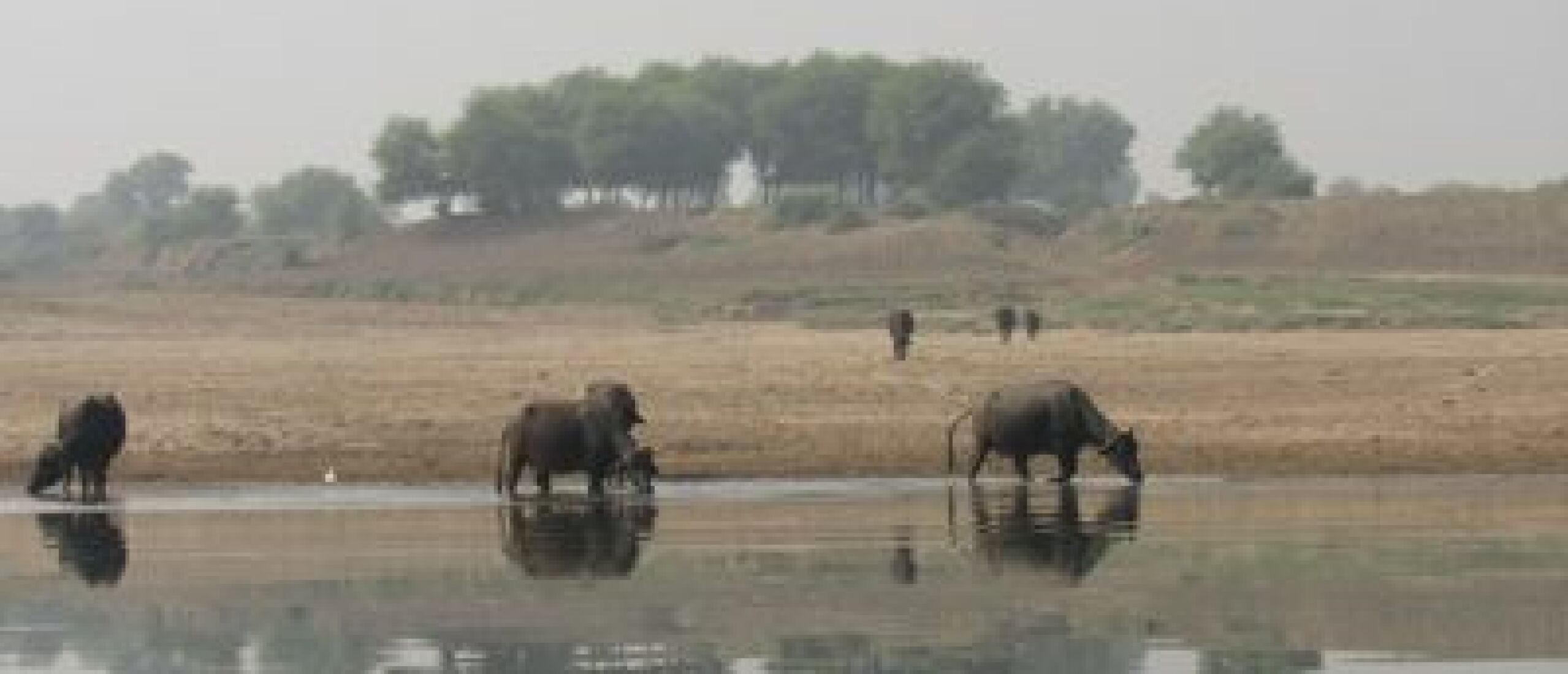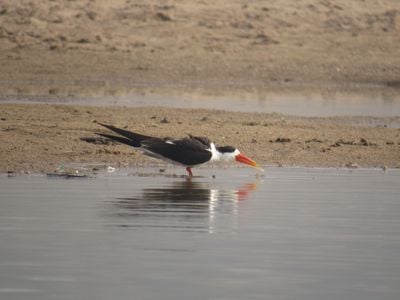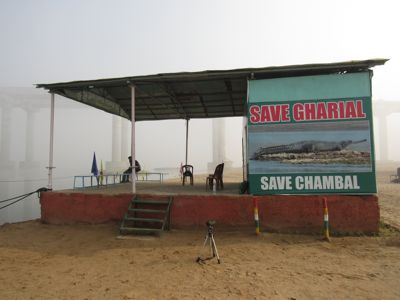
Chambal and the Skimmers On one of the days that we were staying in Bharatpur, Rosemary and I had requested a visit to the Chambal River, a must-see location these days for any birder visiting this area of India. We set off, Sumantha, Bablu and myself crammed into the back seat, and Rosemary and driver Maharaj in the front of our Tata Indica car, for the 60 km journey through some truly grotty Uttar Pradesh towns - one positive factor was the fog, which meant that the litter-strewn environs were not so shocking, but the fog did threaten our chances of spotting wildlife along the Chambal. A brief stop to check a wetland area on the way turned out to be less brief than we had anticipated. Maharaj dropped Sumantha, Bablu and myself on an elevated flyover which should have afforded good views of the wetland below, and he then drove off into the mist with Rosemary. As it was, we could see virtually nothing, and it was not a pleasant place to stand, with traffic thundering past and the flyover trembling with every passing truck. It seemed ages before the car returned; Maharaj had been unable to find a turning point! Finally we arrived at a huge bridge over the Chambal at Dholpur, and after crossing it in thick fog, we descended along a muddy track to the riverbank. Here there was a landing stage, and several large signs advertising the area's wildlife highlights, with exhortations to protect the river's endangered species, but with large amounts of plastic trash floating by. I always find it so sad to see Black-winged Stilts or other birds picking their way through rubbish discarded by humans.
 Initial hopes of good visibility on the Chambal River looked distinctly, or indistinctly, limited!
Initial hopes of good visibility on the Chambal River looked distinctly, or indistinctly, limited!
Although one group of observers did set off in a boat, we were advised to wait a while in the hope that the fog would clear, until finally it was decided that the visibility had improved sufficiently to give us some chance of seeing our main target bird...and we set off.
 Rosemary fully prepared for her Chambal excursion
Rosemary fully prepared for her Chambal excursion
The Chambal River is a tributary of the Yamuna (Jumna), which flows in turn into the Ganges, and it is seen as being one of India's last great pollution-free river systems, although that did not immediately strike me as being the case. A large section of it is protected as the National Chambal Sanctuary, mainly with the aim of providing a safe habitat for three of India's most vulnerable wild creatures, the Gangetic Dolphin, the Gharial and the Indian Skimmer. As a birder, the latter of these three was high on my wants list, and it was not long before some birds on a muddy bank in the distance caused our hopes to rise. We drifted closer, and the fog became thinner, allowing us to gain a better look through the binoculars...and indeed, there they were, three Indian Skimmers perched on the shore.
 Were those Indian Skimmers next to the cormorant?
Were those Indian Skimmers next to the cormorant?
Skimmers are extraordinary birds. Related to terns, they have evolved to exploit a unique feeding style. The lower mandibles of their bright orange bills have become much longer than the upper ones, and they literally skim along the surface of the water, the lower mandible actually in the water, slicing its surface in the hope of scooping up small fish and other aquatic prey. No other bird has a bill like a skimmer, making it one of the World's great ornithological sights.
There are three species of skimmer, the African Skimmer, a near-threatened species which occurs sparingly from Senegal to Angola and the Zambezi, but is nowhere common, the critically endangered Indian Skimmer, whose population may not far exceed 1,000 birds, and the far more numerous Black Skimmer, which occurs in the Americas and which I had seen in considerable numbers on the Pacific coast of Guatemala in 2011. As our boat came closer, we were able to drink in the sight of these bizarre birds. Two were asleep for much of the time, although they did wake up briefly, giving us a splendid view of their bright orange bills, which were translucent towards the tip. The third bird, which was standing slightly apart from the others, was engaged in a very heavy bout of preening, scooping up water in its lower mandible, and using it to clean its feathers. I had noticed this behaviour in the Black Skimmers in Guatemala; the birds have to keep their feathers in tiptop condition, as they actually touch the water at times while skimming, and they must not become waterlogged, so they seem to be fastidious in their attention to cleanliness.
 Two of the Indian Skimmers were asleep for much of the time
Two of the Indian Skimmers were asleep for much of the time
 The third Indian Skimmer was scooping up water in its outsized lower mandible to preen itself with
The third Indian Skimmer was scooping up water in its outsized lower mandible to preen itself with
The main threats to the Indian Skimmer are pollution of its riverine habitat, and disturbance on its nesting areas. All large rivers in the Indian subcontinent are under extreme pressure from mining/dredging for sand and gravel, which is used for construction. Trucks rumble around in the riverbeds, and dogs accompany the dredgers. Even the decrease in vultures that I described two posts ago has led to an increase in House Crows, which prey on the eggs and chicks of Indian Skimmers and other riverine birds. In this area, nests are apparently protected from dogs, roving cattle that trample the nests, and trucks, by being surrounded with cut thorny branches during the nesting season. The authorities are clearly aware of the plight of these vulnerable birds, and such measures do undoubtedly help, although a ring of thorny branches will not prevent crows from raiding the nests.
 Villagers' cattle are a threat to nesting Skimmers, frequently trampling their nests
Villagers' cattle are a threat to nesting Skimmers, frequently trampling their nests
Having savoured the experience of watching the Skimmers, we headed on, shortly afterwards sighting an Osprey and a Laggar Falcon perched in a tree high on the bank. The Laggar was also a life-bird for me, although it could have been classed as what birders sometimes refer to as an "NBV" - Need Better View!
 The impressive sandy cliffs that line this section of the Chambal River
The impressive sandy cliffs that line this section of the Chambal River
Our focus was then diverted towards what had initially looked like logs on the bank; the first turned out to be a large Gharial, another bizarre creature with a very specific adaptation. Unlike other crocodilians, the Gharial has evolved to eat exclusively fish, and its snout has become elongated and narrow to allow it to grasp the slippery fish in its jaws. It also has a bulbous growth on the tip of its snout, and sometimes only this and its eyes protrude above the surface of the water.
 A Gharial, showing its unusual snout with the bulbous growth on the end
A Gharial, showing its unusual snout with the bulbous growth on the end
Gharials are critically endangered, and it was estimated that the global population was only 235 individuals in 2006, occupying less than 2% of the species' original range. Major threats are pollution, fishing with gill nets, stealing of eggs by tribal people who consider them a delicacy, and the young being swept out of the protected areas by monsoon floods. We were lucky to see a few individuals here, accompanied by their cousins the Mugger, or Freshwater Crocodile.
 An impressively sized Mugger was also on the bank
An impressively sized Mugger was also on the bank
A distant view of another rare bird species, the Black-bellied Tern, added that species to the 'NBV' list, and we were treated to closer sightings of Egyptian Vultures, Bar-headed Geese and Lesser Whistling Ducks, before our two hours were nearly up and we had to return to the jetty.
 An Egyptian Vulture by the Chambal River
An Egyptian Vulture by the Chambal River
 A small group of Bar-headed Geese resting on the Chambal shore
A small group of Bar-headed Geese resting on the Chambal shore
 A flock of Lesser Whistling Ducks enjoying the morning sun
A flock of Lesser Whistling Ducks enjoying the morning sun
 Self feeling pleased to have seen the Indian Skimmer after many years of waiting
Self feeling pleased to have seen the Indian Skimmer after many years of waiting
It had been a privilege to observe these special creatures, but as with so much of what I have observed during this journey, I felt concerned that I was watching the endgame for so much of India's wildlife. I often try to console myself with the thought that the country has done wonders to preserve anything at all with its 1.2 billion people, and it is heartening to see how many people are dedicated to wildlife, and no other country in the World has such a marvellous Forest Department (of which my grandfather F W Champion OBE IFS and great uncle Prof. Sir Harry Champion CIE IFS would still be proud), and yet the sight of that trash in what is supposed to be a shining example of an unpolluted river made me sick.
 The Chambal is supposed to be an unpolluted river, yet it is lined with trash
The Chambal is supposed to be an unpolluted river, yet it is lined with trash
After a sandwich lunch by the river, we drove into Dholpur, stopping briefly to look around the impressive Raj Niwas or Dholpur Palace Hotel, a magnificent stately home full of Dutch ceramic tiles, Belgian glass, Victorian bathtubs from the UK, and countless treasures from India and Europe. From here we made our way back through those same grotty towns, this time without the fog to shield us from the grime and plastic filth, until we eventually arrived back in Bharatpur...where we deliberately stopped by another filthy ditch.
 Self, Sumantha Ghosh and Rosemary in the magnificent Raj Niwas Palace, in Dholpur
Self, Sumantha Ghosh and Rosemary in the magnificent Raj Niwas Palace, in Dholpur
One of my abiding memories of my 1988 visit had been observing another unusual bird, the Painted Snipe. Not a snipe at all, the Painted Snipe is a wading bird in which the normal sex roles are reversed. The female is the brightly coloured one, and she has a harem of males, mating with several and then taking no part in the raising of the chicks. We had seen them in a pristine marshy area outside the park, I remembered, but this time the experience was totally different. Carefully avoiding stepping into human excrement, Bablu and I picked our way towards the edge of this stinking ditch, which despite (or perhaps because of) the filth that it contained, and despite the loud honking of passing traffic, seemed to be full of birds, mainly Black-winged Stilts, Wood Sandpipers and Pond Herons. It was not long before we had spotted two pairs of Painted Snipe, and although the circumstances were far from ideal, it was a pleasure to reacquaint myself with this delightful species of bird. And the ironic thing is, if all the filthy places with which India abounds were cleaned up, birds like the Painted Snipe would probably suffer.
 A Painted Snipe accompanied by a plastic bag in the Bharatpur ditch
A Painted Snipe accompanied by a plastic bag in the Bharatpur ditch




